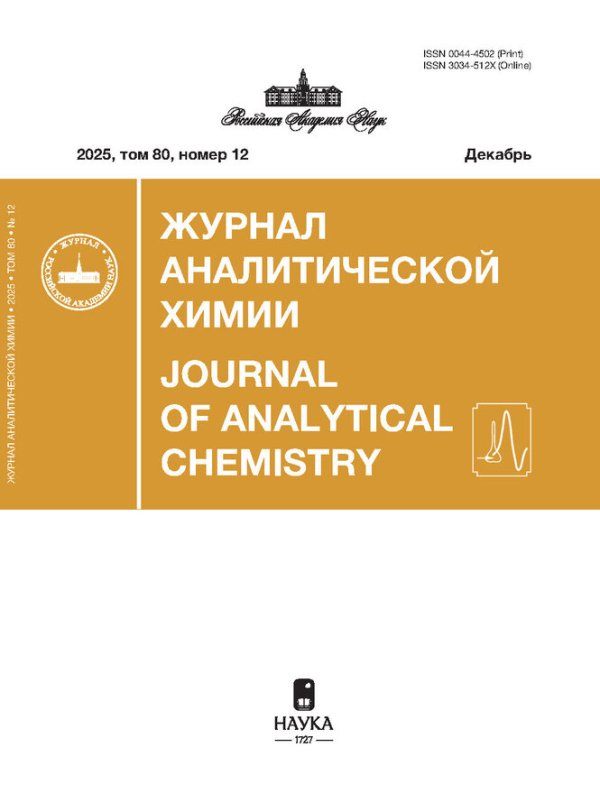Vol 78, No 7 (2023)
REVIEWS
 579-629
579-629


ORIGINAL ARTICLES
Dispersive Liquid–Liquid Microextraction of Preservatives for Their Chromatographic Determination in Beverages
Abstract
A method of dispersive liquid–liquid microextraction, based on the dispersion of an extractant by the gas phase formed as a result of a phase transition, i.e., the evaporation of a highly volatile nonpolar organic solvent (dispersant) upon heating the extraction,—is developed. The analytical capabilities of the method are shown in the determination of preservatives (sorbic and benzoic acids) in soft drinks for baby food by high-performance liquid chromatography with photometric detection. The extractant and the dispersant for the microextraction of preservatives are chosen a terpenoid and a highly volatile organochlorine solvent, respectively, which excluded the use of polar organic solvents for dispersing phases, with which the distribution coefficients are reduced. The limits of detection (3σ) for sorbic and benzoic acids are 0.3 mg/L. The developed method does not require centrifugation for phase separation
 630-636
630-636


Novel Adsorbents for the Determination of Amino Acids in Soil Extracts by Hydrophilic Interaction Liquid Chromatography with Mass Spectrometric Detection
Abstract
Adsorbents based on various substrates—silica and a copolymer of styrene with divinylbenzene—are developed for the determination of amino acids by hydrophilic interaction liquid chromatography—mass spectrometry. The optimal version of the structure of the functional layer in two series of the obtained stationary phases was chosen, which provides the best hydrophilization for each substrate. Retention mechanisms were studied and the conditions for the mass-spectrometric detection, separation, and determination of 16 amino acids were chosen. The applicability of the obtained adsorbents and a method for determining amino acids for the analysis of soil extracts were estimated.
 637-647
637-647


A Voltammetric Sensor Based on Aluminophosphate Zeolite and a Composite of Betulinic Acid with a Chitosan Polyelectrolyte Complex for the Identification and Determination of Naproxen Enantiomers
Abstract
A voltammetric sensor was developed based on a glassy carbon electrode with aluminophosphate zeolite finely dispersed on its surface, modified with a polyelectrolyte complex of chitosan with succinyl chitosan and betulinic acid, for the selective detection and determination of naproxen enantiomers. The electrochemical and analytical characteristics of the sensor were studied, and the effective electrode surface area (A = 9.8 ± 0.5 mm2) and charge transfer resistance (Ret = 649.9 ± 0.4 Ω) were calculated. In determining naproxen enantiomers, calibration characteristics are linear in the range from 2.5 × 10–5 to 1 × 10–3 M with limits of detection of 1.1 × 10–7 and 1.5 × 10–7 M and limits of quantification of 3.6 × 10–7 and 4.9 × 10–7 M for R- and S-naproxen, respectively. The sensor is more sensitive to R-naproxen (∆Ep = 60 mV, ipR/ipS = 1.40). The proposed sensor was used to recognize and determine naproxen enantiomers in human urine and plasma samples. Statistical evaluation of the results by the standard addition method showed that there was no systematic error.
 648-661
648-661


Cathode Nanophosphors
Abstract
High-current cathodic pulses on an aluminum electrode in solutions containing sufficiently high concentrations of Mg, Ca, Sr, Al, Sc, Y, or La nitrates in a mixture with H3BO3, HF, H3PO4, or H4P2O7 are accompanied by an intense intrinsic luminescence of a number of heavy metals, the ions of which are captured by salt nanofilms and luminescence under the action of hot electrons when are in an environment characteristic of crystal phosphors. The effect of the cathode nanophosphor (CNP) was found in more than 100 systems; photographs are presented for most of the systems. Ga, In, Tl, Ge, Sn, Pb, Mn, Cu, Ag, Cd, Ce, Tb, and Zr ions were activators. The effect of matrix composition on the spectral and kinetic characteristics of the CNP was shown on several examples; a qualitative description of the phenomenon is given, and the prospects for its application to chemical analysis are considered.
 662-670
662-670


EVENTS
Гелий Вениаминович Павлинский
 671-672
671-672













